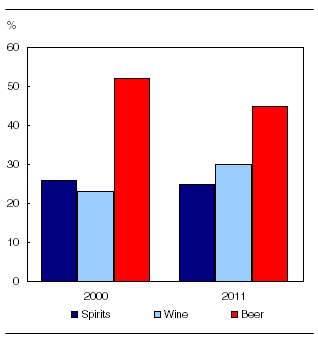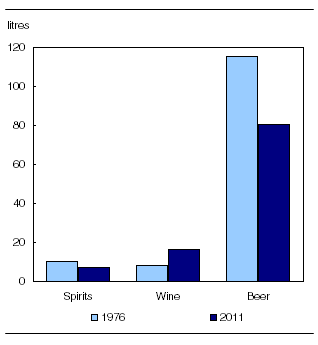Control and sale of alcoholic beverages
Archived Content
Information identified as archived is provided for reference, research or recordkeeping purposes. It is not subject to the Government of Canada Web Standards and has not been altered or updated since it was archived. Please "contact us" to request a format other than those available.
Related subjects
-
[an error occurred while processing this directive]
Beer and liquor stores and agencies sold $20.3 billion worth of alcoholic beverages during the fiscal year ending March 31, 2011, up 2.0% from the previous year. Beer remained the alcoholic drink of choice for Canadians.
The growth in dollar value reflected a combination of factors, including an increase in sales of imported wine and spirits as well as an overall increase of 0.4% in the price of spirits, wines and beer during the fiscal year.
In litres of absolute alcohol, the volume of sales of alcoholic beverages decreased 0.5% to 228.4 million litres.
The net income realized by provincial and territorial liquor authorities, combined with other alcohol-related revenue such as liquor licenses and permits, was up 5.6% to $5.9 billion in 2011 from the previous year. Alberta reported a 4.5% decline in net income, while the rest of the provinces and territories experienced growth.
Imported beer brands still on the rise
Beer and liquor stores and agencies sold $9.1 billion worth of beer during the fiscal year ending March 31, 2011, down 0.4% from the previous year. Yukon had the largest increase in sales at 4.4%, followed by Ontario at 3.1%.
Although beer remained the alcoholic drink of choice, measured in both volume and dollar value, its dominance continued to decline as consumers turned more to wine.
In 2000, beer had a market share of 52% by dollar value, while wine had 23%. By 2011, the market share for beer had declined to 45%, while wine accounted for 30%. The market share of spirits declined marginally by 1% over the same period.
Note to readers
Statistics on sales of alcoholic beverages by volume should not be equated with data on consumption. Sales volumes include only sales by liquor authorities and their agents, and sales by wineries and breweries and outlets that operate under license from the liquor authorities.
Consumption of alcoholic beverages would include all these sales, plus homemade wine and beer, wine and beer manufactured through brew-on-premises operations, sales in duty-free shops and any unrecorded transactions.
Similarly, statistics on sales of alcoholic beverages by dollar value of sales should not be equated with consumer spending on alcoholic beverages. Sales data refer to the revenues received by liquor authorities, wineries and breweries. These revenues include sales to licensed establishments, such as bars and restaurants.
Therefore, sales data do not reflect the total amount spent by consumers on alcoholic beverages, since the prices paid in licensed establishments are greater than the price paid by those establishments to the liquor authorities.
Per capita data are based on the population aged 15 and over.
Volume of sales of alcoholic beverages in litres of absolute alcohol is calculated by multiplying the sales volume by the percentage of alcohol content. For more information on conversion rates, consult the 'definitions, data sources and methods' section of this release.
This release also includes revisions to beer, spirit and wine sales data from 2005/2006 to 2009/2010.
Proportion of sales of alcoholic beverages in dollars

Chart description: Proportion of sales of alcoholic beverages in dollars
Measuring volume, beer stores and agencies sold 2.3 billion litres of beer in 2011, down 2.7% from the previous year.
Sales of alcoholic beverages per capita 15 years and over: Volume

Chart description: Sales of alcoholic beverages per capita 15 years and over: Volume
On a per-capita basis, beer sales amounted to 80.3 litres per person in 2011, down from 85.6 litres in 2000. In contrast, during the same period, beer sales in terms of dollar value increased by almost $47 to $320 per person.
The volume of imported beer sold was down 2.4% to 321.0 million litres in 2011 from 2010. In spite of this decline, imported beer represented 14% of the beer market in Canada, double its share of 7% in 2000.
The principal origins of imported beer sold in Canada were the United States (23.4%), the Netherlands (18.7%) and Mexico (18.5%).
Wine's popularity still on the rise
Wineries and liquor stores and agencies sold $6.1 billion worth of wines during the year ending March 31, 2011, up 5.0% from the previous year.
In terms of volume, wine sales increased 3.0% to 470.0 million litres in 2011 from 2010. The growth in sales of imported wine (+4.8%) outpaced the growth of domestic wine sales (+0.5%).
Dollar sales of red wine almost tripled (+181%) from 2000 to 2011, while dollar sales of white wine (+66%) rose at a much slower pace. The share of imported red wine in 2011 was unchanged at 76% of all red wines sold in Canada, while the share of imported white wine increased from 61% to 62%.
Imported spirits capture greater market share
Liquor stores and agencies sold $5.1 billion worth of spirits during the year ending March 31, 2011, up 2.9% from the previous year. This gain was mainly the result of increases in sales of vodka (+5.0%), rum (+4.1%) and whisky (+2.7%).
The volume of spirits sold increased 0.2% in 2011 to 209.8 million litres. Domestic spirits continued to dominate the market, but their lead has been declining. The volume of imported spirits sold in Canada increased from 26% of all spirits sold in 2000 to 34% in 2011.
Since 2000, the market share by dollar value of whisky-type products, such as whisky, scotch and bourbon, has been declining. Despite the decline, whisky-type products accounted for 27% of total spirits sales in 2011 followed by vodka sales, at 24%, and rum sales, at 17%.
Available without charge in CANSIM: tables 183-0006 and 183-0015 to 183-0020.
Definitions, data sources and methods: survey number 1726.
Data tables on sales of alcoholic beverages are available from the National economic accounts module of our website.
Data are also available through custom and special tabulation. For more information on products and services, contact Client Services (613-951-0767; pssd-info-dssp@statcan.gc.ca). For more information, or to enquire about the concepts, methods or data quality of this release, contact Luqman Rana (613-951-3524; luqman.rana@statcan.gc.ca), or Hiren Parikh (613-951-6695; hiren.parikh@statcan.gc.ca), Public Sector Statistics Division.
- Date modified:
